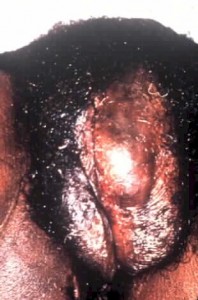A vulvar hematoma is usually the consequence of a “straddle” injury.
When a woman falls while straddling a fixed structure, such as chair, railing, sawhorse or fire hydrant, it is a common occurrence that the peri-clitoral vessels on one side or the other will be crushed against the pubic bone. This results in a vulvar hematoma.

Most of the vulvar enlargement is soft tissue swelling, but some is due to an encapsulated hematoma.
Diagnosis is made on the basis of history of a fall and the typical physical findings of unilateral swelling and pain.
Clinical management consists of:
- An icepack is placed over the perineum and left in place for 24-48 hours. This will help control the pain and limit swelling and further bleeding into the hematoma.
- A Foley catheter is inserted and left in place. The local swelling may be sufficient to impair voluntary voiding and the Foley is much easier to insert earlier in the process.
- Bedrest for several days to a week.
- Appropriate analgesia. Initially, this may need injectable narcotics. Later, oral narcotics and then NSAIDs will give satisfactory results.
Dramatic resolution will occur. When completely healed in a few weeks, the vulva will look normal and function normally.
Most of these hematomas will not require surgical exploration and drainage.
If you explore them, in about half the cases, no bleeding point will ever be found. Opening them introduces bacteria into an otherwise sterile hematoma. Particularly in operational settings, ice, Foley and bedrest are usually better choices for treatment.
In following these, it may prove useful to measure the hematoma with a tape measure to compare the size over time. As they are feeling less pain, patients will often feel that the hematoma is enlarging. Having objective measures of its’ size will be reassuring to the patient.
